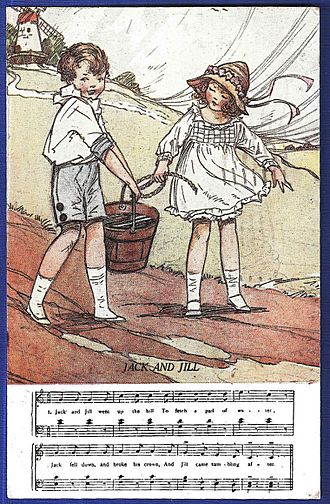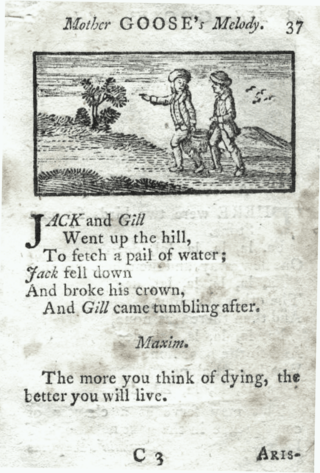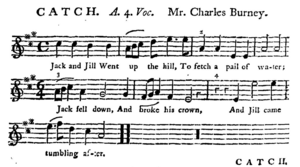Jack and Jill (nursery rhyme) facts for kids

"Jack and Jill" is a very old and famous English nursery rhyme. It tells the story of two friends, Jack and Jill, who go up a hill to get water. The rhyme has been around since the 1700s. Over time, new verses and different versions of the story were added. Many people have tried to figure out where the rhyme originally came from.
Contents
The Original Jack and Jill Rhyme
The first known version of the "Jack and Jill" rhyme appeared in a book called Mother Goose's Melody around 1765 in London. In this early version, Jill was spelled "Gill." An old drawing from that time even showed two boys going up the hill.
The first verse of the rhyme goes like this:
Jack and Gill
Went up the hill
To fetch a pail of water
Jack fell down
And broke his crown,
And Gill came tumbling after.
Later, the spelling changed to Jill. More verses were added to continue the story. The most common added verses are:
Up Jack got
And home did trot,
As fast as he could caper;
Went to bed
To mend his head
With vinegar and brown paper.
Jill came in
And she did grin
To see his paper plaster;
Mother, vex’d,
Did whip her next
For causing Jack's disaster.
In these verses, "broke his crown" means Jack hurt his head. The "vinegar and brown paper" was a common home remedy for bruises back then. The rhyme usually has a bouncy, trochaic rhythm.
How the Story Changed Over Time
Over the years, many new versions of the "Jack and Jill" story appeared. In 1806, a longer story called Jack & Jill and Old Dame Gill was published. This was a "chapbook," a small, inexpensive book. It showed how children's books were starting to become more about fun than just teaching lessons.
This longer version added more adventures for Jack, Jill, and their mother, Dame Gill. They had mishaps with a dog, a goat, and even fell off a see-saw and a swing. Many copies of this book were made, and the stories sometimes changed. More animals like a donkey, reindeer, and camel were added to their adventures.
American Versions of the Rhyme
In America, the story of Jack and Jill also changed. In 1852, a version by Fanny E. Lacy used the rhyme to teach a lesson. After Jack and Jill fell, the poem warned people to be happy with what they have and not try to be too fancy.
Another American book from 1873, Jack and Jill, for old and young, imagined Jack and Jill as grown-ups. They became a hardworking married couple. Their fall from the hill was explained in great detail, and their recovery took many verses.
Some American versions even added completely different verses that are not found in English books:
Little Jane ran up the lane
To hang her clothes a-drying;
She called for Nell to ring the bell,
For Jack and Jill were dying.
Nimble Dick ran up so quick,
He tumbled over a timber,
And bent his bow to shoot a crow,
And killed a cat in the window.
In 1900, a new version called "The New Jack and Jill" appeared. In this one, Jack and Jill went up the hill to get milk. But the cow didn't like it and chased them back down!
Music for Jack and Jill
The "Jack and Jill" rhyme has been set to music many times. One of the earliest musical versions was created by Charles Burney in 1777.
The tune most people know today was first written down by James William Elliott in his book National Nursery Rhymes and Nursery Songs in 1870. This book was also published in America as Mother Goose Set to Music. In 1877, a single-verse version of the rhyme with music appeared in The Baby's Opera.
Later, in 1878, the composer Alfred James Caldicott made a clever musical piece for "Jack and Jill." He was known for mixing simple nursery rhyme words with complex music. Other composers also created musical versions for different groups of singers.
In 1926, Sigmund Spaeth had fun with the rhyme. He adapted "Jack and Jill" into many old musical styles, like a Handel opera or a Wagnerian version. Later, the English composer Geoffrey Hartley created chamber music pieces based on the original rhyme.



